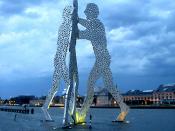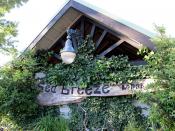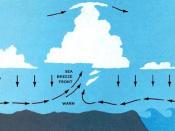Question
Convection can't [simply] happen in solids. Why?
Because there are no free molecules.
Examples of convection
1.Domestic hot water system
Cold water in the tanks is heated by electric element at the bottom. The hot water molecule at the bottom raises up and the cold upper molecules sinks to the bottom. These are also heated and become hot and starts to rise up. The once raised molecules are now cooler and start to sink to the bottom. The cycle is repeated again and again. This is water convection.
2.Breezes
(a) Sea breeze (in the day)
Gentle coast wind blowing off the sea towards the land. Its most noticeable in the summer when the warm land surface heats the air above it and causes it to rise.
Cooler air from the sea is drawn into replace the rising air, so causing an onshore breeze. At night and in winter, air may move in the opposite direction, forming a land breeze.
(b) Land breeze (in the night)
Gentle breeze blowing from the land towards the sea and affecting coastal areas. It forms at night in the summer or autumn, and tends to be cool. By contrast the sea breeze blows from the sea towards the land.
3.Chimneys
Is a tall pipe or structure that carries away smoke or fire. The air above the fire is heated and then expands. The expansion of air makes it to rise up along the chimney. Then the cold air from the outside descends down to take place of the raising hot air. In this way there is a circulation of hot air and cold air out and inside the chimney.
4.Ovens
Is a closed space in which things are cooked or heated? The electric heater heats the air above it making...


